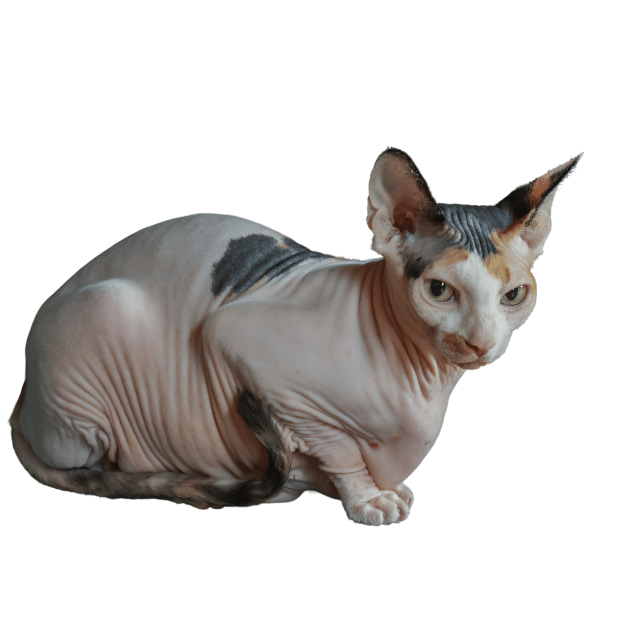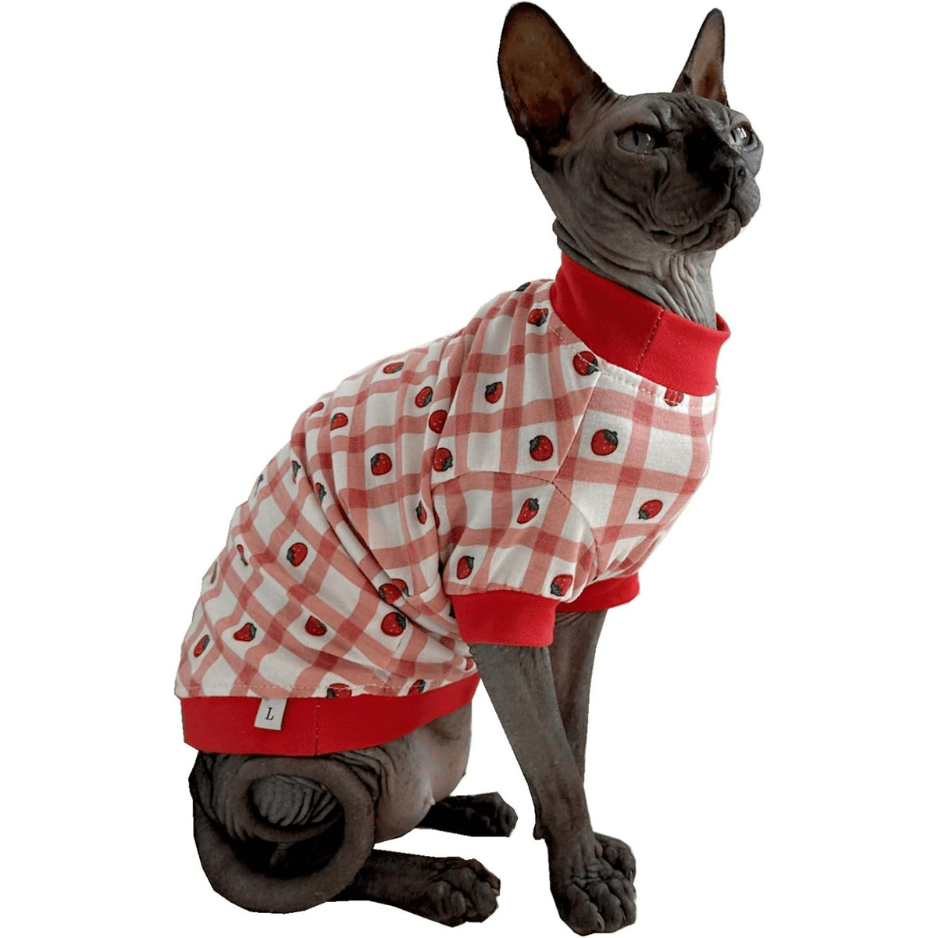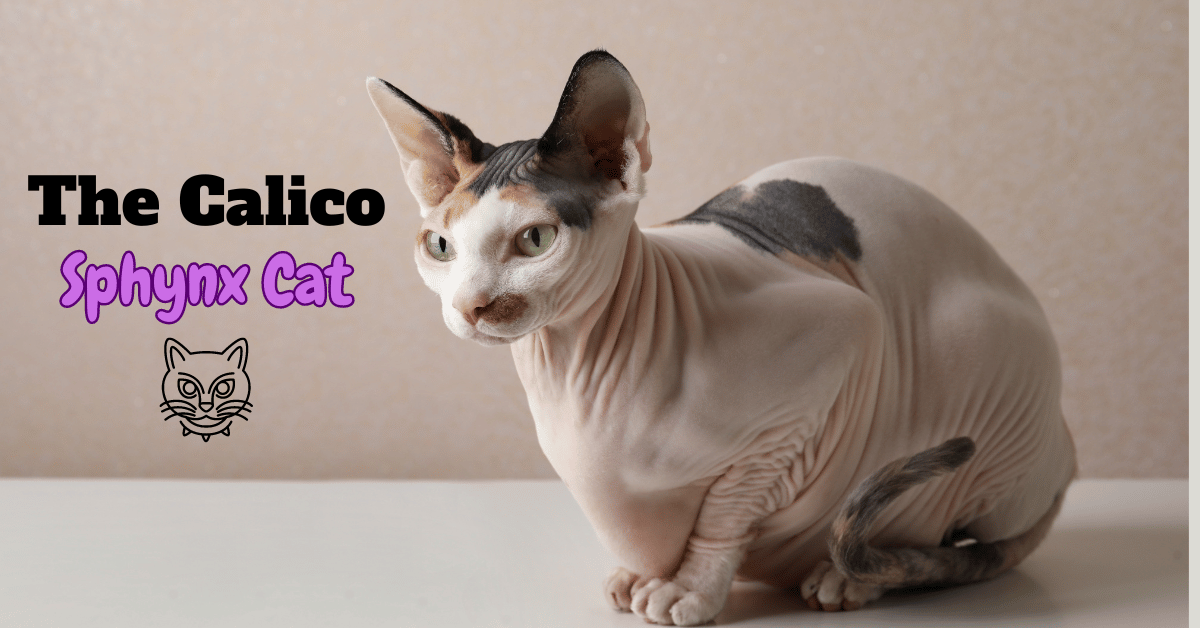This post contains affiliate links and I will be compensated if you make a purchase after clicking on my links.
Introduction to the Calico Sphynx Cat: Unraveling the Tri-Color Mystery
The term “Calico Sphynx Cat” might sound like a special breed, but “calico” actually refers to a color pattern, not a breed. This distinctive tri-color coat, featuring patches of white, black, and orange, usually graces cats with more fur. So, when this vibrant pattern appears on the sleek, hairless Sphynx, it certainly turns heads.

Seeing a Calico Sphynx is an unexpected delight, as this rare coloration makes each cat incredibly unique. While the hairless Sphynx already stands out in the feline world, adding a splash of calico colors elevates their intrigue, blending the unexpected with the traditional in a single cat. In this post, we’ll explore what makes the Calico Sphynx not just visually striking but also a fascinating subject of genetic color distribution and feline beauty.
The Curious Origins of the Calico Sphynx Cat
The story of the Sphynx cat begins not in ancient Egypt, as their name might suggest, but in a much colder locale: Toronto, Canada during the 1960s. Here, a domestic shorthair gave birth to a litter that included a hairless kitten, an anomaly caused by a natural genetic mutation. This kitten, aptly named Prune, marked the beginning of the Sphynx breed.

Prune’s unique appearance sparked interest, and a breeding program was soon established to explore and expand this genetic rarity. The program initially faced many challenges, including a limited genetic pool that led to health issues. However, through careful breeding practices and international collaboration, the breed gradually took shape.
By the early 1970s, the Sphynx gained a foothold in the North American and European cat communities. Breeders from Toronto and Minnesota contributed to establishing the breed’s foundation stock, which would eventually support the burgeoning population of Sphynx cats worldwide.
It’s within this lineage that the calico pattern—typically associated with more traditional, fur-bearing breeds—made its rare yet remarkable appearance in the Sphynx lineage.
The Rise of Calico Sphynx Cat Popularity
As the Sphynx breed developed, so did its notoriety. By the late 1970s, the Sphynx’s distinct appearance and affectionate nature began to attract a wider audience. These cats, known for their dog-like loyalty and social behavior, quickly won over hearts, making them a favorite among cat enthusiasts who appreciated their unique traits.
The Calico Sphynx, with its rare and striking coat, became particularly captivating. The unusual combination of a hairless body adorned with colorful calico patches made these cats not just pets but conversation starters. Their rarity added to their allure, making each Calico Sphynx cat a prized companion in the households lucky enough to have them.
Their rise in popularity was mirrored by a growing interest in cat shows and pet ownership, where the distinctiveness of each breed was celebrated. The Calico Sphynx, in particular, stood out due to its rarity and the compelling story of its genetic lineage, drawing attention from both breeders and potential cat owners.
Formal Recognition and Standards for Calico Sphynx Cats
The formal recognition of the Sphynx breed, including the calico variant, came in the early 2000s. Major cat registries such as the Cat Fanciers Association (CFA), the International Cat Association (TICA), and the Fédération Internationale Féline (FIFe) acknowledged the breed’s distinct qualities and included them in their breed standards.
The CFA was among the first to grant championship status to the Sphynx in 2002, recognizing the breed in all colors and patterns, including several variations of the calico pattern. TICA followed in the 2000s, offering a platform for these cats to be showcased and admired in various competitions and shows. Although the FIFe was more reserved in their breed standards, they too recognized the unique beauty and appeal of the Sphynx.
Unique Genetic Traits of the Calico Sphynx
The Calico Sphynx’s striking coat results from a genetic interplay on the X chromosomes. Typically, females display the calico pattern because they have two X chromosomes, each carrying genes for orange or black fur. Males are less likely to be calico unless they have an extra X chromosome (XXY).
Lyonization, or X-chromosome inactivation, further influences this coloring. Early in embryonic development, one of the X chromosomes in each cell is randomly deactivated. This determines whether a cell produces orange or black fur. Since lyonization happens when the embryo has about eight cells, these cells and their descendants form large, uniform patches of color.
This genetic quirk adds an extra layer of rarity to the Calico Sphynx. Combined with the gene mutation responsible for their hairlessness—a distinct feature attributed to the KRT71 gene—these cats are a remarkable showcase of genetic diversity. The KRT71 mutation affects keratinizing of the hair follicle, which in Sphynx cats results in a complete lack of fur, and in others like the Devon Rex and Selkirk Rex, it leads to uniquely textured coats.
Health and Care Considerations for a Calico Sphynx
While the lack of hair and striking coloration make the Calico Sphynx a standout, these traits also predispose the breed to specific health issues. Like other hairless cat breeds, their exposed skin makes them vulnerable to environmental factors.
Sun exposure can lead to sunburn and, over time, more severe conditions like skin cancer. During colder months, their lack of a natural fur coat means they struggle to retain heat, which necessitates warm, cozy environments and sometimes even clothing.

Furthermore, early life for a Sphynx can be precarious. The same genetic factors that give them their unique appearance can also make them prone to respiratory infections in their kitten stages. Prospective owners need to be vigilant about their Calico Sphynx’s health, ensuring they receive regular veterinary checkups and live in a controlled environment that minimizes risks.
The Calico Sphynx as a Family Pet
Despite these care considerations, the Calico Sphynx makes for an exceptional family pet. Their personality is as vibrant as their coat, characterized by high sociability and affection. They form deep bonds with their owners, similar to those seen in canine-human relationships, and are known to greet their humans at the door with enthusiastic displays of affection.
Their intelligence and eagerness to interact make them highly trainable, which can be a delightful process for owners looking to engage more deeply with their pets. Whether it’s learning tricks or navigating household rules, the Calico Sphynx is an eager participant. Their compatibility with children and other pets makes them an excellent addition to diverse households.
Ready to make a Calico Sphynx or another hairless cat breed part of your family? Equip yourself with the best products for their care and wellbeing. Visit our Hairless Products Catalog to find top-quality items specifically designed for the unique needs of hairless cats.
Meet Sean, a fintech whiz with a penchant for pet purrs and blockchain buzz. After a decade of fintech feats, Sean’s tech talents leaped from ledger lines to litter lines, driven by a passion for pets and a vision for a more connected pet care community. With three critter companions as co-pilots, Sean launched this blog to share a treasury of pet-friendly tech tips and tales.


